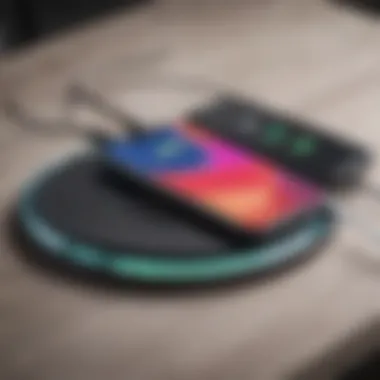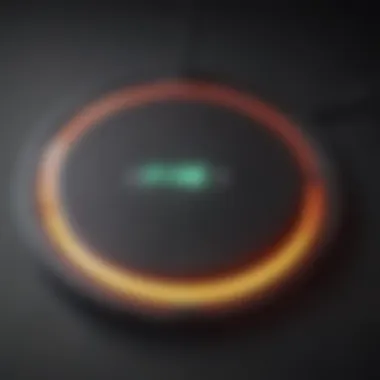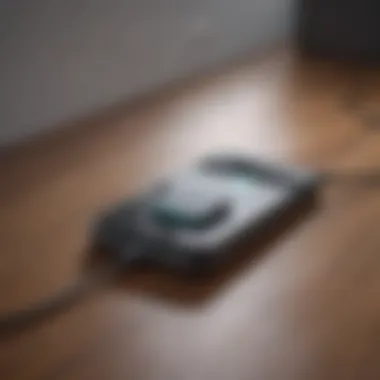Exploring the Best Phone Charging Pads: A Comprehensive Guide


Intro
In today’s fast-paced world, convenience is a high priority, especially for mobile device users. Among the essential gadgets that have emerged, phone charging pads stand out for their practicality and efficiency. A phone charging pad allows for easy and effortless charging without the hassle of cords. This article intends to serve as a comprehensive guide, outlining the factors you should consider when selecting a charging pad.
Understanding the landscape of charging technology is vital. The acquisition of the right charging pad can ensure you have a reliable and efficient power source, tailored to your unique requirements. Topics to be discussed include compatibility with various smartphones, the speed of the charger, design aesthetics, and additional features designed to enhance user experience. Drawing insights from current trends and experiences will also help consumers make informed choices.
Compatibility
When choosing a charging pad, the foremost consideration should be compatibility. Different phones come equipped with varying technologies that affect how they charge wirelessly. Most charging pads follow the Qi standard, which most modern smartphones support, but it’s still crucial to check specific compatibility.
Here is a brief list of various charging pad compatibilities to chew on:
- Apple Devices: Most iPhones from the iPhone 8 onward support Qi.
- Android Devices: Many flagship devices such as Samsung Galaxy series, Google Pixel, and others have extensive Qi compatibility.
- Others: Certain headphones and smartwatches also support wireless charging.
Beyond knowing if the pad works with your specific phone, understanding if it supports features like fast charging is critical. Different types of charging specifications could influence charging performance.
Charging Speed and Efficiency
Charging speed significantly influences user experience. The continuous evolution in technology has led to pads that offer varying transfer speeds. You may find charging pads rated at 5W, 10W, or even 15W for enhanced efficiency. A higher wattage generally translates to faster charging, but ensure this is compatible with your device's capabilities. Native support for fast charging is key for a smooth experience.
Charging time does depend on battery status and environmental factors such as device temperature.
“Understanding your devices and their charging specifications will lead to better charging practices.”
Design and Form Factor
The design of a charging pad includes both aesthetics and functionality. Users often opt for pads that complement their style while being practical. Consider aspects such as:
- Size: Will it sit neatly on your desk or bedside table?
- Cord Length: Ensure your charging pad can conveniently reach an outlet.
- Material: High-quality builds can make a difference in longevity and performance.
Unique features like LED indicators or rubber grips can also enhance functionality, allowing for easy usage in various conditions.
Additional Features
Modern charging pads often come packed with extra features that promote user convenience. Detectors enabled in certain models can identify a device's necessity for lower power in specific scenarios. This can help extend the lifespan of your battery.
Some advanced models also feature:
- Cooling Systems: Prevent devices from overheating.
- Multi-device Capabilities: Allow charging more than one device at a time.
A proper fit for your needs will depend on mobile demands.
Recommendations
Those searching for the best charging pads should keep certain heavyweights in mind. Consider options such as Anker Wireless Charger, Belkin Boost Up Wireless Charging Pad, and Mophie Wireless Charging Pad. Each of these brands has different features addressing specifications, ergonomics, and user reliability. Reading reviews from various sources like Reddit and product webpages can provide valuable feedback.
Prelims
In today's fast-paced world, smartphones serve as essential devices for communication, entertainment, and productivity. With the rise of wireless technology, the way we recharge our devices has undergone a considerable transformation. Phone charging pads have become increasingly popular due to their convenience and efficiency. They simplify the charging process with just a placement rather than fumbling with cords and connectors.
As the market floods with various models and features, understanding the essential attributes becomes vital. This guide is designed to cut through the noise and guide consumers, especially gamers and professional gamers, towards optimal choices.
Key aspects like compatibility, charging speed, and design play a critical role in selecting a suitable charging pad. Moreover, incorporating safety features enhances user confidence during charging. By following this comprehensive guide, the reader will gain insights into what to look for in charging pads and how to choose one that effectively meets their demands.
A thorough examination of the product realm will help illuminate the best options currently available. In evaluating these products, solutions will be provided that accommodate specific user requirements.
Understanding the nuances of phone charging pads can significantly improve your charging experience.
As we delve deeper into the subject matter, we will cover all pertinent aspects of wireless charging technology to ensure informed decision-making.
Understanding Wireless Charging
Wireless charging is an essential topic when discussing the best phone charging pads. This method allows users to charge their devices without the hassle of tangled cords and connectors. The rise in mobile device usage has underscored the importance of understanding how wireless charging works, its benefits, and what to consider when selecting a charging pad.
What is Wireless Charging?


Wireless charging is a technology that transmits power to a device without requiring a physical connection. This is typically achieved using electromagnetic fields. Through inductive coupling, a primary coil in the charger generates a magnetic field,ne ensured adherence to the Qi standard, allowing compatible devices to receive power. As a result, users can charge their phones simply by placing them on the pad, providing convenience and ease in everyday use.
How Wireless Charging Works
The operation of wireless charging might seem complex at first, but it fundamentally relies on simple principles. When a smartphone is placed on a charging pad, the pad sends an alternating magnetic field. This magnetic field generates an electric current in a coil located inside the phone. Once the phone receives enough voltage, it begins charging. Setup is straightforward – just lay down the phone where directed, and that’s it.
Key technologies like Magnetic Resonance are pushing this method further, allowing for greater distances between devices—even if they’re not in direct contact with the charging surface. This is a focal point of future advancements, potentially trivializing wiring even further.
Benefits of Wireless Charging
The discussion around the benefits of wireless charging is pivotal. Firstly, one of the most immediate advantages is convenience. No more fumbling with charging cables or disconnecting them before using the phone. Users can simply lift the phone and go if needed.
Moreover, using a wireless charger can offer additional protection for the charging port on devices. Repeated plugging and unplugging can lead to wear and tear. By reducing this physical interaction, one can prolong the lifespan of devices.
Other practical benefits include:
- Less cable clutter: Eliminates the need for multiple cables at various spots.
- Multi-device capability: Several pads accommodate multiple devices at once, keeping family stations organized.
In summary, as devices evolve, the relevance of efficient charging methods fuels the demand for effective wireless charging solutions. Understanding this technology is, therefore, crucial for consumers looking for not just convenience but also long-term feasible tech solutions.
Key Features of Charging Pads
Phone charging pads are becoming essential gadgets for modern tech users. Understanding their features ensures efficient charging experiences. The selection of a charging pad hinges on various factors, such as its compatibility with devices, charging speed, design, and integrated safety features. Here, we shall break down these features, outlining their significance.
Qi Compatibility
The term Qi represents the universal standard for wireless charging. This compatibility ensures that various devices, such as smartphones, smartwatches, and earbuds, can charge on the same pad. If a charging pad is Qi-certified, it meets rigorous safety and efficiency protocols.
Choosing a Qi-compatible charging pad adds value to your charging routine. It means your devices will be supported now and in the future. As new devices emerge, knowing your pad is up to date in terms of technology offers peace of mind.
Charging Speed
Standard Charging
Standard charging provides a steady rate to devices, often around 5W. This stability is suitable for most users. The primary characteristic of standard charging is its reliability. You can leave your phone unattended, and it safely charges without excessive heat. This makes it a beneficial choice for overnight charging, offering hassle-free use.
Although it fulfills basic charging needs, standard chargers have limitations on time for a full charge. For typical users, these limitations are appropriate. However, for those who seek shorter charging cycles, it might not align effectively with their lifestyle.
Fast Charging
With significant advancements in technology, fast charging has taken charge, quite literally! Fast charging typically delivers up to 15W. The main attraction here is reduced down time. Mobile users, especially gamers, appreciate the convenience of quickly resuming tasks. This feature is popular among heavy device users who wish to avoid interruptions.
Fast charging is not perfect, though. While providing rapid replenishment of battery power, sustaining ongoing use at these higher rates introduces additional heat. Caution must be taken, particularly with older devices that may not be designed to handle such power levels effectively.
Compatibility with Devices
A key element of any charging pad is how suitably it works with different devices. A charging pad should ideally support multiple brands and varied product types. High compatibility ensures versatility, making it a favorable addition for users who have diverse devices.
This characteristic of compatibility fosters a one-stop solution for charging, reducing the clutter from multiple cables or chargers around the house. Limited device compatibility can lead to frustration, as users might find they need to change their pad with a new device.
Design and Build Quality
The visual appeal along with a robust design is important in selecting charging pads. This aspect includes sturdiness, material used, and overall aesthetics. A well-constructed charging pad should withstand daily use without succumbing to superficial damage. Good design enhances the user experience while ensuring the longevity of the product.
Moreover, design plays a role in usability. For instance, anti-slip surfaces can be advantageous in preventing devices from sliding away during charging. A more attractive design potentially makes them a part of the room decor rather than eyesores littering surfaces.
Safety Features
Overheat Protection
Overheat protection serves as an essential feature in charging pads. Devices can overheat during the charging process, especially with high-demand charging.Built-in overheat sensors can stop power transfer if temperatures rise beyond safe levels, which protects both the device and users from hazards.
This preventive measure resonates well with users valuing safety. Overheat protection can enhance battery health in the long-term life span for gadgets, being a plus point many users will appreciate.
Foreign Object Detection


The foreign object detection (FOD) feature enhances safety while charging. It involves detecting if objects like coins or keys are lying on the charging surface that can obstruct the charging process. If detected, charging is halted until the object is removed, which acts as a safety net.
This characteristic minimizes risks such as overheating or physical damage to both the pad and the devices. FOD serves as an unseen protector during your day-to-day usage of wireless charging pads.
Always prioritize charging pads with robust features and guidelines to enjoy a reliable charging experience in today's technology-driven world.
Top Charging Pads Reviewed
The section on Top Charging Pads Reviewed is crucial for anyone looking to invest in a wireless charging solution. Modern consumers have a multitude of options at their disposal, which can make the decision process overwhelming. This review will delve into some of the top models on the market, shedding light on essential features, true performance, and user experiences. These considerations tend to dictate not only the efficiency of the charging pads but also the value they provide over time. Thus, the right choice contributes to a seamless electronic ecosystem in a professional or gaming environment.
Model A: Overview and Features
Model A offers robust charging capabilities alongside a sleek design. This charging pad accommodates various devices, thanks to its Qi compatibility. The charging speed of Model A is optimal for quick energy boosts during those crucial gaming breaks or work deadlines. Additional elements include a non-slip surface which prevents devices from sliding off during charging. The build is designed for durability and style, complementing any setting.
Model B: Overview and Features
Introducing Model B, a versatile charging pad suitable for both personal and commercial spaces. What sets Model B apart is its ability to fast charge multiple devices at once, an ideal feature for multi-taskers. It also includes a smart indicator that tells users when devices are correctly aligned for charging. Moreover, its design emphasizes sync with home aesthetics and is available in multiple finishes.
Model C: Overview and Features
Model C shines with its cutting-edge technology aimed at efficient power transfer. It supports latest smartphones and accessories with speed without heat. Users appreciate its integrated overheating protection, which ensures the pad remains safe to use in various scenarios. Moreover, the design features a visual aesthetic that aligns with modern hardware.
Model D: Overview and Features
For the eco-conscious consumer, Model D represents sustainable and efficient design. It promotes responsible charging methods by using recycled materials in its construction. Users find that its portability is a significant advantage. Being lightweight, it easy to take along during travel, making it excellent for gamers on the go.
Model E: Overview and Features
Finally, Model E stands out for its adaptive charging capabilities. This product smartly adjusts its charging output depending on the connected device's requirements. This dynamic feature is especially useful for those who frequently switch between different brands and models. Additionally, the visual cues built into the design provide instant feedback on charging status, enhancing user experience.
When selecting a charging pad, consider your own usage habits and device compatibility.
Each of these models has unique benefits tailored to particular needs. They all meet a rigorously preset criteria for performance, safety, and style. This ensures users find a charging pad that seamlessly integrates into their lifestyle.
Comparative Analysis
The comparative analysis focuses on the essential evaluation of phone charging pads. Understanding how different models stack up against each other is crucial for making an informed purchasing decision. This section underscores elements such as effective performance, value for money, and user satisfaction. A systematic comparison not only allows consumers to identify the best options available but also enables them to prioritize features that align with their unique needs.
Price vs.
Performance
When examining price versus performance, cost often plays a critical role in decision making. A higher-priced charging pad might suggest better build quality or faster charging capabilities; however, this is not always guaranteed. One must consider what factors warrant a premium price. Sometimes, mid-range models given positive reviews outperform their high-end counterparts.
Key considerations when evaluating price and performance include:
- Charging Speed: Faster charging pads save time. Speed can depend on both the pad and the device.
- Durability: The materials used effect the lifespan of the pads. Pay attention to the warranty offerings.
- Compatibility: Not all pads work equally with all devices, which can impact overall value.
In practical application, investing in a well-reviewed pad can lead to cost savings in terms of time and efficiency in device usability.
User Experience and Reviews
User experience serves as a sophisticated gauge of product reliability. It's beneficial to read reviews and user experiences before making a purchase. General satisfaction ratings can provide insight into how effective a product truly is.
Important elements of user experience to analyze include:
- Ease of Use: Users appreciate intuitive designs that prevent hassle.
- Heat Management: Effective heat dissipation ensures devices do not overheat during charging.
- Aesthetics: Visual appeal can be a deciding factor for consumers, influencing enjoyment and perceived value.
Reviews can often highlight common issues or benefits not mentioned in manufacturer specifications. Paying attention to feedback can reveal potential flaws or superior features you may not consider initially.
Considering both price and user experiences guides consumers towards making choices that increase satisfaction and efficiency.
Buying Considerations
When purchasing a phone charging pad, several key factors should influence your decision-making process. Understanding buying considerations is essential for making a wise investment in this technology that quickly becomes a part of daily life. The right charging pad not only compliments your phone but also enhances its functionality.


Several elements play a significant role in determining which product best suits your requirements. Compatibility, charging speed, design, and safety features are among the main considerations. Assessing these factors can lead to improved charging efficiency and ultimately enhance user satisfaction.
Assessing Your Needs
Identifying your needs is the first step in selecting a compatible charging pad. Consider what devices you own. Some charging pads support multiple devices while others focus solely on a specific brand or model. Make sure that the charging pad is Qi-compatible if you have Qi-enabled devices. Evaluate how you intend to use the charging pad as well—will it be a static location at home or do you need portability for frequent travels? Understanding your lifestyle alignment with charging pads helps narrow down your options significantly.
Key Points to Consider:
- Device Models: Verify compatibility with your phone model.
- Space & Location: Decide where the charging pad will be used most often.
- Additional Uses: Consider if you need the pad to charge other devices like headphones or smartwatches.
Choosing the Right Brand
Brand selection can significantly impact your experience with a charging pad. Reputation may provide insight into product reliability. Some brands are recognized for their advancements in technology, while others are noted for user-friendly designs. Knowledge of the market can guide your decision here. Be wary of obscure brands presenting offers too-good-to-be-true; they may compromise on quality.
Popular Brands to Consider:
- Anker
- Belkin
- Mophie
- Samsung
- Apple
Take your time to read reviews or seek recommendations to ensure consistency in quality and performance.
Warranty and Customer Support
Investing in a charging pad easily leads buyers to consider both warranty and customer service offered. These factors act as a safety net, providing peace of mind. A strong warranty underscores confidence in the product and its durability. Additionally, user experiences differ widely, hence the need for reliable customer support cannot be underestimated.
Why These Should Matter:
- Warranty: Ensures coverage against defects for a specified period, allowing for replacements or repair.
- Customer Support: Essential to resolve issues effectively and improve user experience.
Purchasing decisions should focus not just on physical attributes but also on accompanying support elements. Always confirm what warranties are available and the responsiveness of customer support options the brand offers.
Future Trends in Wireless Charging Technology
As the world shifts increasingly toward wireless solutions, understanding future trends in wireless charging technology becomes critical. This section explores innovations that aim to enhance efficiency, integrate with existing smart ecosystems, and influence consumer choices in the smartphone charging landscape.
Advancements in Charging Efficiency
Charging efficiency is a primary concern among users, particularly with an array of devices utilizing wireless charging pads. Recent developments focus on enhancing the energy transfer process. Manufacturers are experimenting with different coil designs and materials to minimize wasted energy during charging.
Higher efficiency leads to faster charging times, a crucial factor for people who rely heavily on devices. For instance, new technologies, such as resonant inductive charging, allow distance charging without precise alignment. This is particularly useful for gamers often on-the-go. Increased efficiency results also in less heating, prolonging the device's battery lifecycle, which negates concerns about long-term usage. The following points highlight areas in future charging efficiency enhancements:
- Multi-device Charging: Advancements aim at supporting multiple devices on a single, efficient pad, catering to users with various electronics.
- Higher Power Output: Innovations are underway to facilitate higher wattage delivery, significantly reducing charging times.
- Smart Load Management: Newer charging pads will feature intelligent circuitry that can adjust power delivery based on the required charging need of the device.
Increased efficiency translates into user satisfaction, making charging less of an inconvenience and more of a seamless experience.
Integration with Smart Homes
As homes become smarter, integrating wireless charging systems into ongoing smart home designs becomes vital. Users will seek charging solutions that communicate intelligently with their surrounding devices. This trend is mainly driven by the rise of intelligent assistants like Amazon Alexa and Google Assistant,
Smart charging pads can act as hubs to manage energy usage and increase convenience. For example, imagine a scenario where your smart device prioritizes a quick battery boost during urgent notifications bieng pushed through your digital coach. Highlight frontal designs will allow placement flexibility, working in tandem with overall home automation plans.
Consider these aspects for future wireless charging integration:
- Object Recognition: Future smart pads could recognize devices and adjust power output accordingly, ensuring no two devices receive the same charging power without optimization.
- *Data Exchange: Advanced pads could facilitate information exchange between different devices, enhancing overall coordination within smart homes.
- Design Compatibility: Wireless chargers may begin to take on versatile designs that mimic other home decorations, increasing their aesthetic attraction while ensuring functionality.
In summary, advancements in charging efficiency and integration with smart homes are vital aspects of ongoing wireless charging evolution. These issues will influence consumer choices in technology as they gravitate towards smarter, more efficient charging solutions.
Epilogue
The conclusion serves as a crucial part of this article, summarizing the discussions around the best phone charging pads. Understanding how these chargers work and what to consider helps consumers make an informed choice.
Several elements have been examined, including compatibility, charging speeds, and overall design features. These factors are not merely trivial; they hold substantial importance in bridging the gap between user experience and technology performance.
Benefits of Quality Charging Pads:
- Efficient Charging: Investing in a robust charging pad significantly reduces the time it takes to charge devices, essential for gamers needing consistent access.
- Reduced Clutter: A well-designed charging pad may eliminate cables spreading across the workspace, promoting a tidier environment.
- Enhanced Safety Features: Modern charging pads include protective mechanisms, such as overheat protection and foreign object detection, which contribute to safe charging practices.
Before making a purchase, consumers should re-evaluate their needs once again. Potential buyers must assess their current device by checking if it supports Qi wireless charging specifications. Additionally, considering aspects like where or how the pad will be used can further guide the decision.
Overall, the market offers a variety of options in phone charging mats, and being knowledgeable empowers them to support individual desires effectively in reliability and functionality.
As we conclude this exploration, the insight gained here echoes primarily across gamers and those seeking high-performance solutions. With the right charging pad, one can not only maintain their device efficiency but also foster a reliable relationship with technology that aligns with fast-paced lifestyles.



